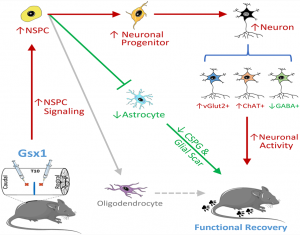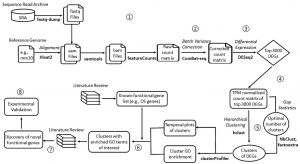Research
The Cai Laboratory: Advancing Therapies for Central Nervous System Disorders
- Developing gene therapy for spinal cord injury
The Cai laboratory is dedicated to developing better therapies and cures for central nervous system injuries, such as traumatic spinal cord injury (SCI). Restoring function after SCI requires repairing and reconstructing the damaged local circuitry. Major hurdles in neural regeneration include limited neurogenesis in the adult spinal cord, an inflammatory microenvironment that inhibits neurogenesis, axon regeneration, neuronal relay formation, and myelination at the injury site – despite extensive research, achieving neuroregeneration and functional recovery after SCI remains extremely challenging.
Neural stem/progenitor cells (NSPCs) persist in the adult spinal cord and represent a potential source of neural cells for wound healing and tissue regeneration after injury. SCI activates endogenous NSPCs residing around the central canal in the ependymal region. However, adult NSPCs in the spinal cord predominantly differentiate into astrocytes and oligodendrocytes. Using mouse models and tissue engineering approaches, the Cai lab aims to uncover the mechanisms underlying tissue damage repair and regeneration and develop effective therapeutic strategies for SCI.

- Elucidating the molecular mechanisms of retinal development and degenerative diseases
Topoisomerase II beta (Top2b) is an enzyme that catalyzes DNA strand passage reactions by moving one DNA duplex through a Top2b-linked transient double-strand break in another. During development, Top2b expression is found only in post-mitotic cells, not in proliferating cells, suggesting its role in cell differentiation, maturation, and maintenance rather than cell proliferation. Mutations in TOP2B are linked to global developmental delay and intellectual disability, possibly due to its requirement for the transcription elongation of long genes necessary for proper development.
We have demonstrated that Top2b deficiency affects developmentally regulated genes and causes defects in the retina. However, the affected cell types and underlying molecular changes are not well characterized. Using conditional knockout mouse models, we study the role of Top2b in photoreceptor development and diseases.

- Creating computational tools for analyzing gene expression and regulation
We leverage existing knowledge and perform innovative computational analyses of existing data, allowing us to explore questions in the aforementioned research areas.